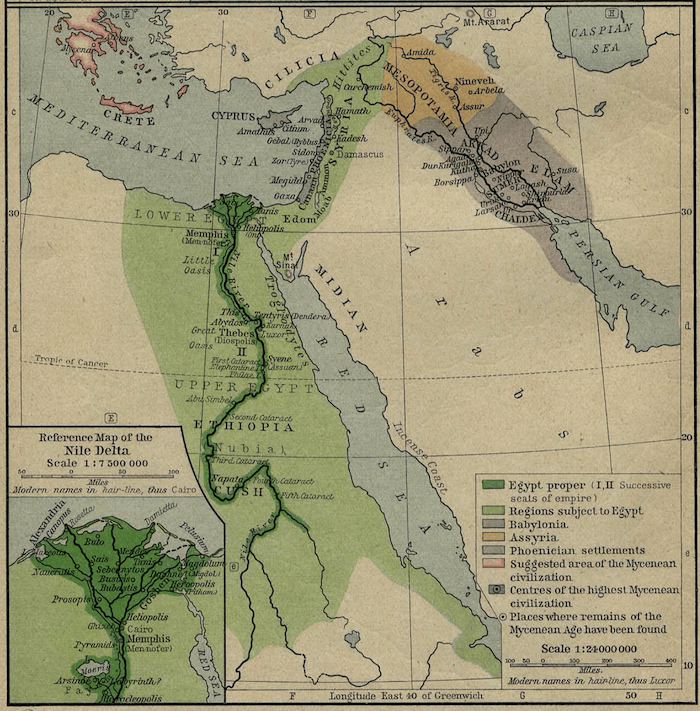Ancient Egypt History > New Kingdom of Egypt
New Kingdom of Egypt

Background
The New Kingdom Period which lasted from 1530 to 1070 BCE would see the civilization of Egypt turn into an effective military state much like the later Neo-Assyrian Empire. Taking advantage of the political instability in the Second Intermediate Period, the Hyksos people took control over Egypt and would establish one of the most culturally significant dynasties in all of Egypt's history.
During this period the king of Egypt became not just a religious leader but also a general and a military commander as well. This is the period of famous rulers such as king Tutankhamen (1333-1323 BCE) and Ramesses II (1290-1224 BCE).

Egypt & Mesopotamia Map (1450 BCE) - Historical Atlas (1923)
The New Kingdom rulers reasserted control over the entire region and relied on tribute from subjected territories to maintain their wealth and power. During this time the king became both a political leader as well as a general and was elevated to the status of demi-god. The Hyksos brought many technical improvements to Egypt as well as many new cultural traditions. They brought new techniques of bronze working and pottery along with new animals and crops. They introduced the horse and chariot to Egypt along with the composite bow, battle axes and advanced fortifications. All of these advances would help propel Egypt to become an ancient world superpower.

Egyptian Queen & Noblewomen - History of Costume (1880)

Ceylon
It was during this time that Egypt was known to have been engaging in the trading of cinnamon with the civilization of Ceylon which was located on the island of Sri Lanka off the coast of Africa. This extensive trading network shows the Egyptians traded all throughout the ancient world from the bottom of Africa all the way through Greece and Mesopotamia. These extensive trading routes allowed the massive proliferation of ideas which would also have an unintended side effect a few hundred years later.
The New Kingdom of Egypt, spanning roughly from around 1550 BCE to 1077 BCE, was one of the most prosperous and powerful periods in ancient Egyptian history. It marked a time of great military conquests, monumental building projects, cultural flourishing, and international influence. Here's an overview of the New Kingdom of Egypt:
Rise to Power:
- The New Kingdom began with the overthrow of the Hyksos, a foreign dynasty that had ruled over parts of northern Egypt during the Second Intermediate Period.
- Ahmose I, the founder of the Eighteenth Dynasty, led the successful campaign to expel the Hyksos from Egypt and reunify the country under native Egyptian rule.
Military Conquests:
- The New Kingdom was characterized by ambitious military campaigns and territorial expansion. Egyptian pharaohs, such as Thutmose III, Amenhotep II, and Ramesses II, led numerous military expeditions into neighboring regions, including Nubia, Palestine, Syria, and the Levant.
- These conquests brought vast territories and resources under Egyptian control, enriching the kingdom and enhancing its power and prestige on the international stage.
Monumental Building Projects:
- The New Kingdom witnessed a resurgence of monumental architecture and construction projects, including temples, palaces, tombs, and statues.
- Pharaohs commissioned grandiose temples dedicated to the gods, such as Karnak and Luxor temples in Thebes, as well as massive mortuary complexes, including the Temple of Hatshepsut at Deir el-Bahari and the Ramesseum.
- The Valley of the Kings, located near Thebes (modern-day Luxor), became the royal necropolis where many pharaohs of the New Kingdom were buried in elaborately decorated tombs.
Cultural Flourishing:
- The New Kingdom was a period of cultural renaissance, marked by advancements in art, literature, religion, and science.
- Egyptian artists produced exquisite works of art, including relief sculptures, statues, and paintings, characterized by their realism, detail, and vibrant colors.
- Literature flourished during this period, with the composition of literary texts such as the "Instructions" literature, hymns, poems, and religious texts.
International Trade and Diplomacy:
- The New Kingdom era saw Egypt engage in extensive trade networks and diplomatic relations with foreign powers, including the Hittites, Assyrians, Mitanni, and Mycenaeans.
- Egyptian merchants traded goods such as gold, ivory, incense, timber, and luxury items with neighboring kingdoms and distant lands, contributing to Egypt's wealth and prosperity.
Decline and End:
- The New Kingdom began to decline in the late Twentieth Dynasty due to a combination of factors, including internal instability, foreign invasions, economic challenges, and political fragmentation.
- The reign of Ramesses XI witnessed the breakdown of central authority and the emergence of powerful local rulers known as the "High Priests of Amun" in Thebes.
- The New Kingdom came to an end with the collapse of the Twentieth Dynasty and the onset of the Third Intermediate Period, characterized by political fragmentation and foreign invasions.
In summary, the New Kingdom of Egypt was a period of unprecedented power, wealth, and cultural achievement. It saw Egypt reach the zenith of its power, with pharaohs conducting successful military campaigns, building magnificent monuments, and promoting cultural and intellectual advancements that left a lasting legacy on world history.
